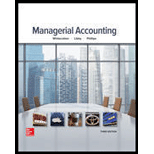
Identify and briefly describe the assumptions of CVP.
Introduction:
Cost-volume profit analysis is a tool that helps in decision making by establishing a relationship between volume, price, variable cost, fixed cost and profit.
To identify and describe:
The assumptions of CVP.
Answer to Problem 1Q
The assumptions of CVP are:
- Linear cost and revenue function
- Cost can be categorized as either fixed or variable
- Only volume affects total cost and total revenue.
- Volume of production is equals to volume of sales
- Product mix is constant
Explanation of Solution
The assumptions of CVP are:
Linear cost and revenue function:
A straight line is used to describe the relationship between total cost and sales volume and total revenue and sales volume.
Cost can be categorized as either fixed or variable:
To find mixed cost, we must determine total fixed cost and variable cost per unit.
Only volume affects total cost and total revenue:
Other factors such as employee learning curve, productivity gains etc. are ignored.
Volume of production is equals to volume of sales:
It is assumed that There will not be any change in beginning or ending inventory, it is assumed that all the units produced are sold during a period.
Product mix is constant:
The companies dealing in multiple products assumes that units sold, or sales revenue generated from each product or service line remains constant.
Want to see more full solutions like this?
Chapter 6 Solutions
Managerial Accounting
- Please provide the solution to this general accounting question using proper accounting principles.arrow_forwardMeagan Industries completes Job #843, which has a standard of 450 labor hours at a standard rate of $24.50 per hour. The job was completed in 420 hours, and the average actual labor rate was $25.20 per hour. What is the labor efficiency (quantity) variance?arrow_forwardSolve this Accounting Problemarrow_forward
- Harmony Beverages produces a fruit juice blend using three ingredients: Apple, Orange, and Mango. The standard mix ratio is 50% Apple, 30% Orange, and 20% Mango. The standard cost per gallon is $2.00 for Apple, $3.50 for Orange, and $5.00 for Mango. Standard production calls for 100 gallons of ingredients to yield 95 gallons of finished juice due to waste. Last week, the company used 60 gallons of Apple, 25 gallons of Orange, and 20 gallons of Mango, which yielded 98 gallons of finished juice. Calculate the materials yield variance.arrow_forwardWhat is the company's projected net operating profit after tax for 2024?arrow_forwardCan you solve this general accounting problem using appropriate accounting principles?arrow_forward
- I need help finding the accurate solution to this general accounting problem with valid methods.arrow_forwardPlease provide the accurate answer to this general accounting problem using valid techniques.arrow_forwardThe monthly fee (in dollars) for a streaming service at Madison Entertainment is a linear function of the number of devices registered. The monthly fee for 3 devices is $19.95 and the monthly fee for 6 devices is $31.95. What is the monthly fee for 4 devices? solve this accounting problemarrow_forward
 EBK CONTEMPORARY FINANCIAL MANAGEMENTFinanceISBN:9781337514835Author:MOYERPublisher:CENGAGE LEARNING - CONSIGNMENT
EBK CONTEMPORARY FINANCIAL MANAGEMENTFinanceISBN:9781337514835Author:MOYERPublisher:CENGAGE LEARNING - CONSIGNMENT Intermediate Financial Management (MindTap Course...FinanceISBN:9781337395083Author:Eugene F. Brigham, Phillip R. DavesPublisher:Cengage LearningPrinciples of Accounting Volume 2AccountingISBN:9781947172609Author:OpenStaxPublisher:OpenStax College
Intermediate Financial Management (MindTap Course...FinanceISBN:9781337395083Author:Eugene F. Brigham, Phillip R. DavesPublisher:Cengage LearningPrinciples of Accounting Volume 2AccountingISBN:9781947172609Author:OpenStaxPublisher:OpenStax College



